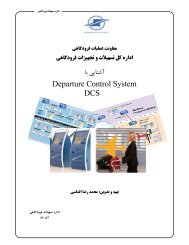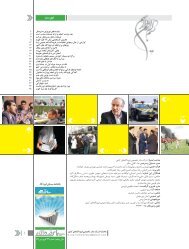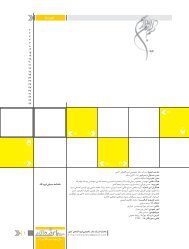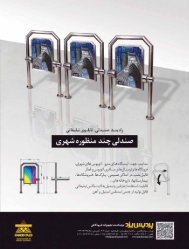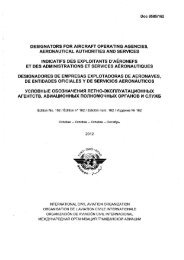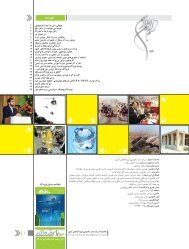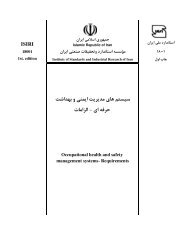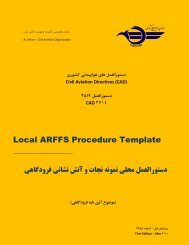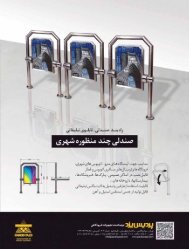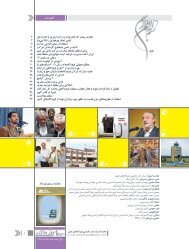ICAO Abbreviations and Codes
ICAO Abbreviations and Codes
ICAO Abbreviations and Codes
Create successful ePaper yourself
Turn your PDF publications into a flip-book with our unique Google optimized e-Paper software.
1-34 <strong>ICAO</strong> <strong>Abbreviations</strong> <strong>and</strong> <strong>Codes</strong> (PANS-ABC)<br />
Variations from the mean wind speed<br />
(gusts) (followed by figures in<br />
METAR/SPECI <strong>and</strong> TAF) G . . .<br />
Vector to final<br />
VTF<br />
Vertical<br />
VER<br />
Vertical navigation (to be pronounced<br />
“VEE-NAV”)<br />
VNAV†<br />
Vertical path angle<br />
VPA<br />
Vertical speed<br />
VSP<br />
Vertical take-off <strong>and</strong> l<strong>and</strong>ing<br />
VTOL<br />
Vertical visibility (followed by figures in<br />
METAR/SPECI <strong>and</strong> TAF) VV . . .<br />
Very high frequency [30 to 300 MHz] VHF‡<br />
Very high frequency direction-finding<br />
station<br />
VDF<br />
Very important person<br />
VIP‡<br />
Very long range<br />
VLR<br />
Very low frequency [3 to 30 kHz] VLF<br />
VHF omnidirectional radio range VOR‡<br />
Vicinity<br />
VCY<br />
Vicinity of the aerodrome (followed by<br />
FG = fog, FC = funnel cloud,<br />
SH = shower, PO = dust/s<strong>and</strong> whirls,<br />
BLDU = blowing dust, BLSA =<br />
blowing s<strong>and</strong>, BLSN = blowing snow,<br />
DS = duststorm, SS = s<strong>and</strong>storm,<br />
TS = thunderstorm or VA = volcanic<br />
ash, e.g. VCFG = vicinity) VC . . .<br />
Visibility<br />
VIS<br />
Visibility, cloud <strong>and</strong> present weather<br />
better than prescribed values or<br />
conditions (to be pronounced<br />
“KAV-OH-KAY”)<br />
CAVOK†<br />
Visual approach chart (followed by<br />
name/title) VAC . . .<br />
Visual approach slope indicator systems VASIS<br />
Visual-aural radio range<br />
VAR<br />
Visual flight rules<br />
VFR‡<br />
Visual manoeuvre with prescribed track VPT<br />
Visual meteorological conditions VMC‡<br />
Visual reference to the ground, by VSA<br />
Volcanic ash<br />
VA<br />
Volcanic ash advisory centre<br />
VAAC<br />
VOR airborne equipment test facility VOT<br />
VOR <strong>and</strong> TACAN combination VORTAC†<br />
W<br />
Warning<br />
WRNG<br />
Waterspout<br />
WTSPT<br />
Way-point<br />
WPT<br />
We agree or It is correct (to be used in<br />
AFS as a procedure signal) OK*<br />
Weaken or weakening<br />
WKN<br />
Weather<br />
WX<br />
Wednesday<br />
WED<br />
Weight<br />
WT<br />
West or western longitude<br />
W<br />
Westbound<br />
WB<br />
West-north-west<br />
WNW<br />
West-south-west<br />
WSW<br />
What is my distance to your station? or<br />
Your distance to my station is<br />
(distance figures <strong>and</strong> units) (to be<br />
used in radiotelegraphy as a Q Code) QGE<br />
White<br />
W<br />
White type of ice formation, opaque OPA<br />
Wide area augmentation system WAAS†<br />
Widespread<br />
WDSPR<br />
Width or wide<br />
WID<br />
Will comply<br />
WILCO†<br />
Will you give me the position of my<br />
station according to the bearings<br />
taken by the D/F stations which you<br />
control? or The position of your<br />
station according to the bearings<br />
taken by the D/F stations that I<br />
control was . . . latitude . . . longitude<br />
(or other indication of position), class<br />
. . . at . . . hours (to be used in<br />
radiotelegraphy as a Q Code) QTF<br />
Will you indicate the TRUE track to<br />
reach you? or The TRUE track to<br />
reach me is . . . degrees at . . . hours<br />
(to be used in radiotelegraphy as a Q<br />
Code)<br />
QUJ<br />
Will you relay to . . . free of charge? or I<br />
will relay to . . . free of charge (to be<br />
used in AFS as a Q Code)<br />
QSP<br />
Wind<br />
WIND<br />
Wind direction indicator<br />
WDI<br />
Wind shear<br />
WS<br />
___________________<br />
† When radiotelephony is used, the abbreviations <strong>and</strong> terms are transmitted as spoken words.<br />
‡ When radiotelephony is used, the abbreviations <strong>and</strong> terms are transmitted using the individual letters in non-phonetic form.<br />
* Signal is also available for use in communicating with stations of the maritime mobile service.<br />
# Signal for use in the teletypewriter service only.<br />
18/11/10



